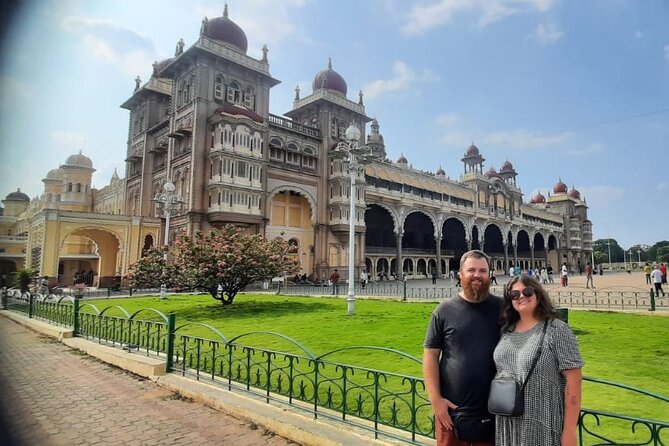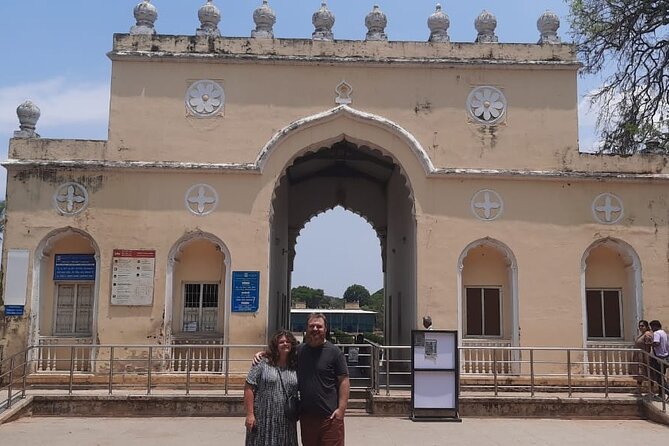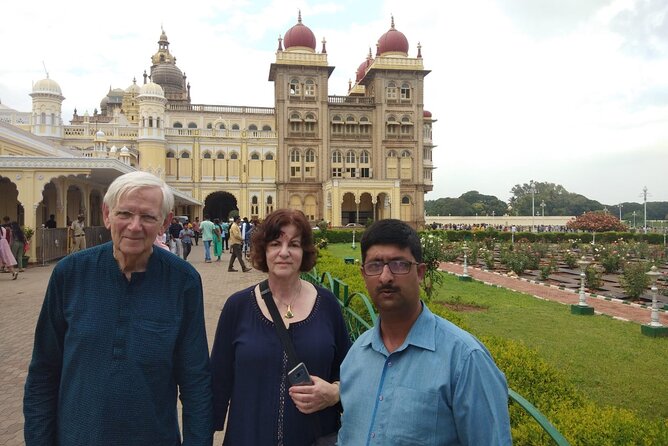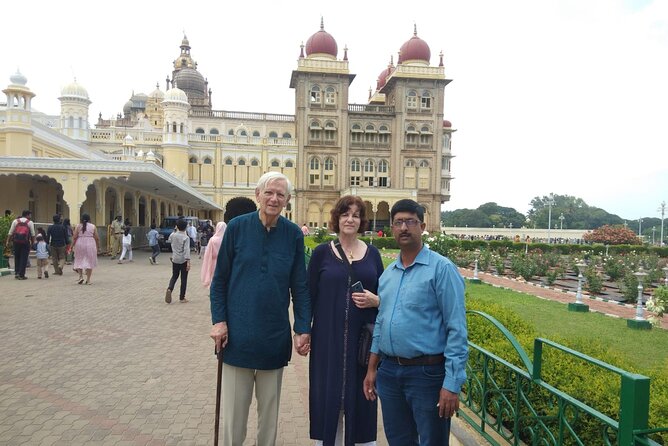With over 50,000 temples scattered across the region, South India boasts a staggering number of architectural wonders that have captivated historians and travelers alike.
The intricate details and spiritual significance imbued in these structures offer a glimpse into a world where art, religion, and culture intertwine seamlessly.
As one delves into the architectural landscape of South India, a mesmerizing journey awaits, unveiling the stories etched in stone and the legacy of craftsmanship passed down through generations.
Explore the depths of South India’s architectural heritage to uncover the secrets held within these timeless monuments.
Good To Know

- South Indian architecture blends traditional and modern styles seamlessly.
- Cultural influences from Dravidian, Chola, and Pallava styles shape architectural marvels.
- Sustainable construction practices and eco-friendly designs are prominent in South Indian architecture.
- Iconic temples and palaces stand as living embodiments of rich cultural and spiritual heritage.
Architectural Marvels of South India
South India boasts a rich tapestry of architectural marvels that showcase a blend of intricate craftsmanship and cultural significance. These structures have been influenced by contemporary styles while also embracing sustainable practices.
The amalgamation of modern elements with traditional techniques has resulted in awe-inspiring buildings that not only stand as a testament to the region’s architectural prowess but also highlight its commitment to environmentally conscious construction methods.
From innovative use of materials to energy-efficient design principles, South Indian architectural marvels aren’t only visually stunning but also serve as beacons of sustainable development. Visitors to the region are treated to a visual feast of structures that seamlessly blend past and present, all while championing eco-friendly practices for a better tomorrow.
Find more activities and experiences we've covered in Bangalore.
Influences on South Indian Architecture

Drawing from a diverse range of cultural influences, the architecture of South India reflects a captivating blend of historical traditions and artistic innovations.
Cultural Influences: South Indian architecture showcases influences from Dravidian, Chola, Pallava, and Vijayanagara styles.
Historical Significance: Temples like the Brihadeeswarar Temple in Thanjavur and the Meenakshi Temple in Madurai stand as iconic examples of South Indian architectural prowess.
Artistic Innovations: Elaborate carvings, intricate sculptures, and towering gopurams are key features of South Indian temples.
Influences from Abroad: The architecture also absorbed influences from trade interactions with regions like Southeast Asia, resulting in a unique fusion of styles.
Traditional Building Materials and Techniques

Traditional building materials and techniques in South India have played a significant role in shaping the architectural landscape of the region. Sustainable practices are deeply rooted in the construction methods, with materials like wood, clay, stone, and thatch being commonly used due to their availability and eco-friendliness.
Artistic craftsmanship is evident in the intricate carvings, vibrant murals, and detailed sculptures that adorn many structures, showcasing the skilled artisanal heritage of the region. Techniques such as interlocking stone blocks, wooden beam construction, and terracotta tiling have been passed down through generations, ensuring the preservation of traditional architectural styles.
The blending of sustainable practices with artistic craftsmanship continues to define the unique architectural identity of South India.
Iconic Temples and Sacred Structures
The architectural splendor of South India is epitomized by its iconic temples and sacred structures, each a testament to the region’s rich cultural and spiritual heritage. These structures aren’t merely buildings; they’re living embodiments of centuries-old traditions and beliefs, attracting pilgrims and travelers alike to witness their grandeur.
- Sacred Rituals: These temples are hubs of religious practices where devotees engage in various ceremonies and rituals to express their faith.
- Spiritual Significance: The temples hold immense spiritual value, often believed to be sanctuaries where you can connect with the divine.
- Architectural Marvels: Intricate carvings, towering gopurams, and majestic pillars adorn these temples, showcasing the skilled craftsmanship of the artisans.
- Historical Legacy: Many of these structures have stood for centuries, preserving not just architectural beauty but also tales of the past.
Palaces and Forts in South India

Nestled amidst the vibrant landscapes of South India are magnificent palaces and formidable forts that narrate tales of opulence and power through their grand architecture. These structures stand as testaments to the region’s rich cultural heritage and serve as reminders of the royal residences that once graced the land. The intricate designs, towering walls, and strategic layouts of these palaces and forts showcase the architectural brilliance of their time. Visitors can explore the lavish interiors, expansive courtyards, and commanding viewpoints that offer glimpses into a bygone era of splendor and authority.
| Palaces | Forts |
|---|---|
| Mysore Palace | Golconda Fort |
| Thanjavur Maratha Palace | Bekal Fort |
| Padmanabhapuram Palace | Chitradurga Fort |
| Bangalore Palace | Dindigul Fort |
- Bangalore: India Esim Roaming Mobile Data Plan
- From Bangalore:Taj Mahal and Agra Private Guided Tour
- Bangalore: Private Car Hire and Driver With Flexible Options
- From Bangalore: Temple Art and Architecture of Lepakshi
- From Bangalore:Taj Mahal and Agra Private Guided Tour
- Day Excursion of Belur, Halebeedu & Shravanabelagola
Modern Architectural Developments
Among the bustling cityscapes and verdant landscapes of South India, a new wave of innovative architectural designs emerges, blending modern aesthetics with cultural influences.
Sustainable designs are becoming increasingly prevalent, with architects incorporating eco-friendly materials and energy-efficient technologies.
Contemporary influences such as sleek lines, minimalist designs, and glass facades are reshaping the skyline of South Indian cities.
Green spaces and rooftop gardens are being integrated into new constructions, promoting a harmonious balance between urban development and nature.
Adaptive reuse of old buildings and structures is gaining popularity, preserving the region’s heritage while giving new life to historical sites.
Unique Features of South Indian Architecture

Amidst the modern architectural developments shaping South India, the unique features of its traditional architecture stand out as a testament to the region’s rich cultural heritage and artistic ingenuity.
South Indian architecture is renowned for its intricate carvings, vibrant colors, and distinct regional influences that set it apart from other architectural styles in India. One of the most striking aspects is the use of Dravidian style temple towers, known as gopurams, characterized by their pyramid-like structures adorned with sculptures of gods, goddesses, and mythical creatures.
Artistic details such as sculpted pillars, ornate ceilings, and elaborate frescoes showcase the craftsmanship and creativity prevalent in South Indian architectural masterpieces. These features not only highlight the architectural prowess of the region but also serve as a reflection of its rich cultural tapestry.
Preservation Efforts and Future Trends
Efforts to preserve and enhance South India’s architectural heritage are continuously evolving to ensure the legacy of the region’s cultural marvels for future generations. Preservation initiatives and sustainable practices play a crucial role in safeguarding these historical treasures.
- Implementing conservation projects to restore ancient structures to their former glory.
- Introducing eco-friendly construction techniques to reduce the environmental impact.
- Engaging local communities in heritage awareness programs to instill pride and stewardship.
- Collaborating with governmental bodies and international organizations to secure funding for restoration efforts.
Frequently Asked Questions
What Are the Best Times of Year to Visit South India to See the Architecture at Its Best?
The best times to visit South India for capturing architectural photography are during the cooler months of November to February. This period showcases traditional elements beautifully while allowing visitors to appreciate ongoing conservation efforts in preserving these historical treasures.
Are There Any Lesser-Known Architectural Gems in South India That Are Worth Visiting?
Hidden gems in South India offer explorers unique architectural fusion, showcasing offbeat structures. Preservation efforts highlight cultural significance while promoting sustainable practices. Discover lesser-known wonders that enrich the region’s heritage and charm.
How Have Contemporary Architects in South India Been Incorporating Traditional Architectural Elements Into Modern Buildings?
Contemporary architects in South India seamlessly blend traditional elements with modern designs, creating a cultural continuity that captivates. By infusing historical motifs into sleek structures, they honor the past while shaping the future of architecture.
Are There Any Specific Architectural Tours or Workshops Available for Visitors Interested in Learning More About South Indian Architecture?
Visitors seeking architectural workshops and cultural experiences in South India can explore design influences and preservation efforts through guided tours. These immersive experiences offer insights into the region’s rich architectural heritage fused with contemporary practices.
What Are Some of the Biggest Challenges Facing the Preservation of South Indian Architectural Heritage, and What Efforts Are Being Made to Address Them?
Preservation efforts for South Indian architectural heritage face challenges like urbanization, lack of funding, and inadequate maintenance. Conservation projects, community involvement, and educational programs are being implemented to address these issues and safeguard the region’s rich architectural legacy.
The Sum Up
To sum it up, the architecture of South India is a captivating blend of intricate carvings, majestic palaces, and ancient temples that showcase the region’s rich cultural and historical heritage.
From the influences of Dravidian and Chola styles to modern developments, each structure tells a story of artistic brilliance and cultural evolution.
Through preservation efforts and future trends, the architectural marvels of South India continue to inspire and awe visitors with their beauty and grandeur.
More Tour Reviews in Bangalore
- Heritage Mysore & Laidback Coorg From Bangalore
- Authentic Shopping Experience in Bangalore for Souvenirs & Gifts
- Bangalore’s Best: A Cultural and Historical Trail
- Srirangapatna & Hosaholalu – Of Forts, Temples And Farms
- Excursion To Karkala And Moodabidri From Mangalore
- Temple Run Thro Hindu/Christian/Islam/Budhism/Sikh/Jain Religions
Looking for something different? Other Bangalore activities we've written about
- 5 Best 3 Day Tours In Bangalore
- 2 Best Bike Tours In Bangalore
- 10 Best Shopping Tours In Bangalore
- 7 Best Workshops And Classes In Bangalore
- 20 Best Historical Tours In Bangalore
- 25 Best Tours In Bangalore
- 11 Best 2 Day Tours In Bangalore
- Best 4 Day Tours In Bangalore
- 11 Best Private Driver Services In Bangalore
- 15 Best Full-Day Tours In Bangalore
- Best Boat Tours And Cruises In Bangalore
- 25 Best Guided Tours In Bangalore
